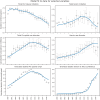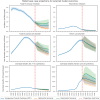Modeling the evolution of the US opioid crisis for national policy development
- PMID: 35639699
- PMCID: PMC9191351
- DOI: 10.1073/pnas.2115714119
Modeling the evolution of the US opioid crisis for national policy development
Abstract
The opioid crisis is a major public health challenge in the United States, killing about 70,000 people in 2020 alone. Long delays and feedbacks between policy actions and their effects on drug-use behavior create dynamic complexity, complicating policy decision-making. In 2017, the National Academies of Sciences, Engineering, and Medicine called for a quantitative systems model to help understand and address this complexity and guide policy decisions. Here, we present SOURCE (Simulation of Opioid Use, Response, Consequences, and Effects), a dynamic simulation model developed in response to that charge. SOURCE tracks the US population aged ≥12 y through the stages of prescription and illicit opioid (e.g., heroin, illicit fentanyl) misuse and use disorder, addiction treatment, remission, and overdose death. Using data spanning from 1999 to 2020, we highlight how risks of drug use initiation and overdose have evolved in response to essential endogenous feedback mechanisms, including: 1) social influence on drug use initiation and escalation among people who use opioids; 2) risk perception and response based on overdose mortality, influencing potential new initiates; and 3) capacity limits on treatment engagement; as well as other drivers, such as 4) supply-side changes in prescription opioid and heroin availability; and 5) the competing influences of illicit fentanyl and overdose death prevention efforts. Our estimates yield a more nuanced understanding of the historical trajectory of the crisis, providing a basis for projecting future scenarios and informing policy planning.
Keywords: fentanyl; heroin; overdose mortality; prescription opioids; simulation modeling.
Conflict of interest statement
The authors declare no competing interest.
Figures





References
-
- Hedegaard H., Miniño A. M., Warner M., “Drug overdose deaths in the United States, 1999-2018” NCHS Data Brief No. 394 (National Center for Health Statistics, Hyattsville, MD, 2020). - PubMed
-
- National Academies of Sciences Engineering and Medicine, Pain Management and the Opioid Epidemic: Balancing Societal and Individual Benefits and Risks of Prescription Opioid Use (The National Academies Press, 2017). - PubMed
Publication types
MeSH terms
Grants and funding
LinkOut - more resources
Full Text Sources
Medical

